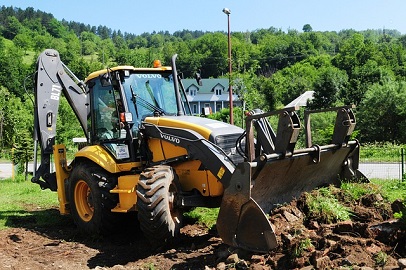Spoil
In the construction industry, the term 'spoil' generally refers to excavated or unwanted material that is removed from the construction site during excavation, earthworks, foundation construction and so on.
Spoil may include soil, rock or other debris that is not useful or necessary for the construction project. It is typically removed from the site and disposed of at a designated facility.
The amount of spoil generated during construction can vary greatly depending on the nature and size of the project, the ground conditions, and the construction methods used. Managing spoil is an important aspect of construction, as improper handling and disposal of spoil can lead to environmental pollution.
In some cases, spoil may be reused or recycled on site, such as by using excavated soil for backfill or landscaping. This can help reduce the amount of material that needs to be disposed of, and may also give cost savings. However, this is not always feasible, in particular in areas where the soil quality is poor or the ground is contaminated.
The amount of spoil generated by the UK construction industry varies from year to year depending on the level of construction activity and the nature of the projects being undertaken. According to data from the UK government's Waste Data Flow report for 2019, the construction, demolition, and excavation sector generated a total of 59.4 million tonnes of waste, of which 29.3 million tonnes was excavated waste, including spoil. The report notes that the majority of excavated waste is disposed of in landfill sites, although some of it is reused or recycled, primarily for land restoration or landscaping purposes.
It's worth noting that the UK construction industry has set targets for reducing waste and improving sustainability, including through the use of more efficient construction methods, reducing the use of virgin materials, and increasing the reuse and recycling of construction waste, including spoil. This reflects a growing awareness of the environmental impact of construction activities and a desire to improve the sustainability of the industry as a whole.
[edit] Related articles on Designing Buildings
Featured articles and news
The UK's Modern Industrial Strategy: A 10 year plan
Previous consultation criticism, current key elements and general support with some persisting reservations.
Building Safety Regulator reforms
New roles, new staff and a new fast track service pave the way for a single construction regulator.
Architectural Technologist CPDs and Communications
CIAT CPD… and how you can do it!
Cooling centres and cool spaces
Managing extreme heat in cities by directing the public to places for heat stress relief and water sources.
Winter gardens: A brief history and warm variations
Extending the season with glass in different forms and terms.
Restoring Great Yarmouth's Winter Gardens
Transforming one of the least sustainable constructions imaginable.
Construction Skills Mission Board launch sector drive
Newly formed government and industry collaboration set strategy for recruiting an additional 100,000 construction workers a year.
New Architects Code comes into effect in September 2025
ARB Architects Code of Conduct and Practice available with ongoing consultation regarding guidance.
Welsh Skills Body (Medr) launches ambitious plan
The new skills body brings together funding and regulation of tertiary education and research for the devolved nation.
Paul Gandy FCIOB announced as next CIOB President
Former Tilbury Douglas CEO takes helm.
UK Infrastructure: A 10 Year Strategy. In brief with reactions
With the National Infrastructure and Service Transformation Authority (NISTA).
Ebenezer Howard: inventor of the garden city. Book review.
The Grenfell Tower fire, eight years on
A time to pause and reflect as Dubai tower block fire reported just before anniversary.
Airtightness Topic Guide BSRIA TG 27/2025
Explaining the basics of airtightness, what it is, why it's important, when it's required and how it's carried out.
Construction contract awards hit lowest point of 2025
Plummeting for second consecutive month, intensifying concerns for housing and infrastructure goals.
Understanding Mental Health in the Built Environment 2025
Examining the state of mental health in construction, shedding light on levels of stress, anxiety and depression.























Comments
[edit] To make a comment about this article, or to suggest changes, click 'Add a comment' above. Separate your comments from any existing comments by inserting a horizontal line.